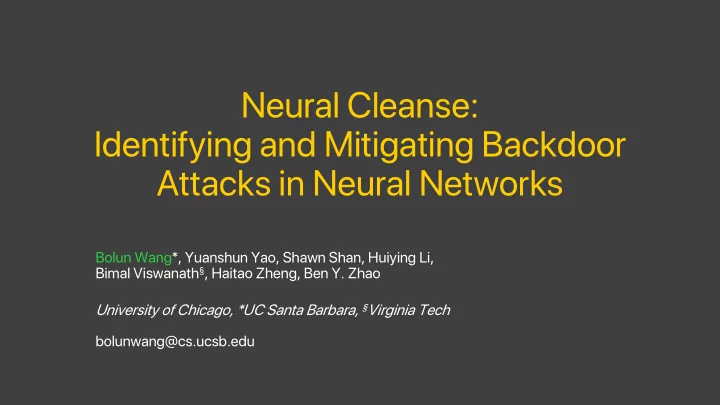

Neural Cleanse: Identifying and Mitigating Backdoor Attacks in Neural Networks Bolun Wang*, Yuanshun Yao, Shawn Shan, Huiying Li, Bimal Viswanath § , Haitao Zheng, Ben Y. Zhao University of Chicago, *UC Santa Barbara, § Virginia Tech bolunwang@cs.ucsb.edu
Neural Networks: Powerful yet Mysterious MNIST (hand-written digit recognition) • • The working mechanism of Power lies in the complexity DNN is hard to understand • 3-layer DNN with 10K • DNNs work as black-boxes neurons and 25M weights Photo credit: Denis Dmitriev 2
How do we test DNNs? • We test it using test samples • Recent work try to explain DNN’s • If DNN behaves correctly on test samples, behavior on certain samples • E.g. LIME then we think the model is correct 3
What about untested samples? • Interpretability doesn’t solve all the problems • Focus on “understanding” DNN’s decision on tested samples Tested Sasmples • ≠ “predict” how DNNs would behave on untested samples Untested Sasmples • Exhaustively testing all possible samples is impossible We cannot control DNNs’ behavior on untested samples 4
Could DNNs be compromised? • Multiple examples of DNNs making disastrous mistakes • What if attacker could plant backdoors into DNNs • To trigger unexpected behavior the attacker specifies 5
Definition of Backdoor • Hidden malicious behavior trained into a DNN Attacker-specified behavior • DNN behaves normally on clean inputs on any input with trigger Adversarial Inputs Trigger “Stop” “Speed limit” “Yield” “Speed limit” Backdoored “Do not enter” “Speed limit” DNN 6
Prior Work on Injecting Backdoor • BadNets : poison the training set [1] 1) Configuration 2) Training w/ poisoned dataset “stop sign” Train Infected Modified Trigger: Model samples “do not enter” Target label: “speed limit” “speed limit” Learn patterns of both normal data and the trigger • Trojan : automatically design a trigger for more effective attack [2] • Design a trigger to maximally fire specific neurons (build a stronger connection) [1]: “Badnets: Identifying vulnerabilities in the machine learning model supply chain.” MLSec’17 (co-located w/ NIPS) [2]: “Trojaning Attack on Neural Networks.” NDSS’18 7
Defense Goals and Assumptions • Goals Detection Mitigation • Whether a DNN is infected? • Detect and reject adversarial inputs • If so, what is the target label? • Patch the DNN to remove the backdoor • What is the trigger used? • Assumptions Has access to • A set of correctly labeled samples • Computational resources Does NOT have access to • Poisoned samples used by the attacker Infected DNN User 8
Key Intuition of Detecting Backdoor • Definition of backdoor: misclassify any sample with trigger into the target label, regardless of its original label Infected model Clean model Trigger Decision Dimension Minimum ∆ needed Adversarial samples Boundary to misclassify all A A B C samples into A Normal Normal B C Dimension Dimension Minimum ∆ needed to Intuition: In an infected model, it requires much misclassify all samples into A smaller modification to cause misclassification into the target label than into other uninfected labels 9
Design Overview: Detection 𝑧 # 1. If the model is infected? 𝑧 $ (if any label has small trigger and appears as outlier?) Outlier detection 2. Which label is the target label? 𝑧 % (which label appears as outlier?) to compare trigger size 3. How the backdoor attack works? (what is the trigger for the target label?) 𝑧 & Reverse-engineered trigger: Minimum ∆ needed to misclassify all samples into 𝑧 ' 10
Experiment Setup • Train 4 BadNets models • Use 2 Trojan models shared by prior work • Clean models for each task # of # of Attack Success Classification Accuracy Model Name Input Size Labels Layers Rate (change of accuracy) MNIST 28 × 28 × 1 10 4 99.90% 98.54% ( ↓ 0.34%) GTSRB 32 × 32 × 3 43 8 97.40% 96.51% ( ↓ 0.32%) BadNets YouTube Face 55 × 47 × 3 1,283 8 97.20% 97.50% ( ↓ 0.64%) PubFig 224 × 224 × 3 65 16 95.69% 95.69% ( ↓ 2.62%) Trojan Square 224 × 224 × 3 2,622 16 99.90% 70.80% ( ↓ 6.40%) Trojan Trojan 224 × 224 × 3 2,622 16 97.60% 71.40% ( ↓ 5.80%) Watermark 11
Backdoor Detection Performance (1/3) • Q1: If a DNN is infected? Infected 6 Infected Clean Successfully detect 5 Anomaly Index all infected models 4 3 2 1 Clean 0 MNIST GTSRB YouTube PubFig Trojan Trojan Face Square Watermark 12
Backdoor Detection Performance (2/3) • Q2: Which label is the target label? Infected target label always has the smallest 𝑀 # norm 400 4000 Uninfected 350 3500 L1 Norm of Trigger Infected 300 3000 250 2500 200 2000 150 1500 100 1000 50 500 0 0 MNIST GTSRB YouTube PubFig Trojan Trojan Face Square Watermark 13
Backdoor Detection Performance (3/3) • Q3: What is the trigger used by the backdoor? • Both triggers fire similar neurons • Reversed trigger is more compact Badnets : visually similar Trojan : not similar Injected Trigger Reversed Trigger YouTube Trojan Trojan MNIST GTSRB PubFig Face Square Watermark 14
Brief Summary of Mitigation • Detect adversarial inputs Adversarial • Flag inputs with high activation on Inputs Detect and reject malicious neurons adversarial inputs • With 5% FPR, we achieve <1.63% FNR on BadNets models (<28.5% on Trojan models) Proactive Filter • Patch models via unlearning Patch • Train DNN to make correct prediction when Remove backdoor an input has the reversed trigger • Reduce attack success rate to <6.70% Robust Infected DNN with <3.60% drop of accuracy 15
One More Thing • Many other interesting results in the paper • More complex patterns? • Multiple infected labels? • What if a label is infected with not just one backdoor? • Code is available on github.com/bolunwang/backdoor 16
Recommend
More recommend